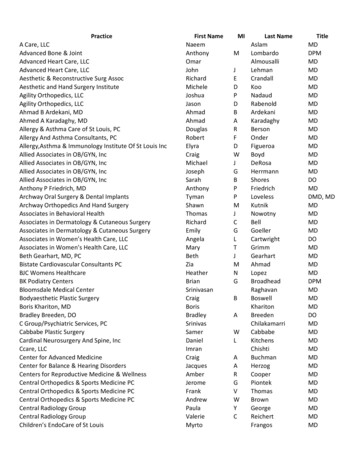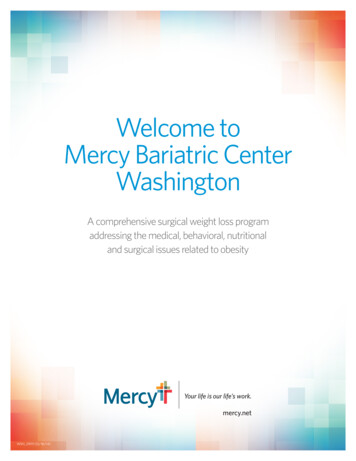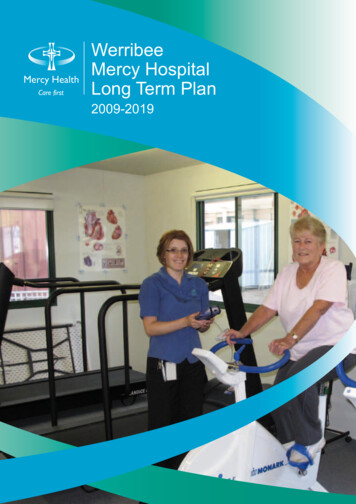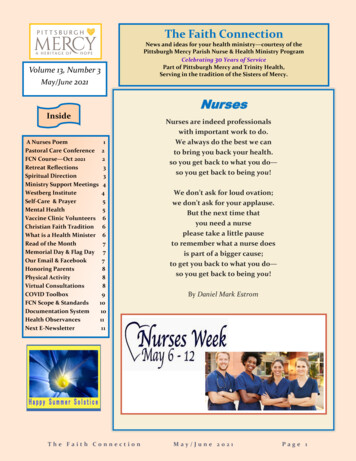
Transcription
Presence Mercy Medical CenterPresence Fox KnollPresence McAuley ManorPresence Home CareCommunity Health Needs AssessmentImplementation Strategy2013 - 2016
Table of ContentsMinistry Overview . 1Target Areas and Populations . 3Identification of Community Needs . 9Identifying Community Priorities . 15Development of the Implementation Strategy . 17Action Plan with Presence Health’s Involvement in Addressing the Needs. 19Next Steps for Priorities . 37Priorities Not Being Addressed by Presence Mercy Medical Center. 38Implementation Strategy Approval . 39Implementation Strategy Communication . 40Kane County Community2013 - 2016 Implementation Strategy
Ministry OverviewProvena Health and Resurrection Health Care merged on November 1, 2011 to form a newhealth system, Presence Health, creating a comprehensive family of not-for-profit health careservices and the single largest Catholic health system in Illinois. Presence Health embodies theact of being present in every moment we share with those we serve and is the cornerstone of apatient, resident and family-centered care environment. “Presence” Health embodies the waywe choose to be present in our communities, as well as with one another and those we serve.Building on the faith and heritage of our founding religious congregations, we commit ourselvesto these values that flow from our mission and our identity as a Catholic health care ministry: Honesty: The value of Honesty instills in us the courage to always speak the truth, to actin ways consistent with our Mission and Values and to choose to do the right thing. Oneness: The value of Oneness inspires us to recognize that we are interdependent,interrelated and interconnected with each other and all those we are called to serve. People: The value of People encourages us to honor the diversity and dignity of eachindividual as a person created and loved by God, bestowed with unique and personalgifts and blessings, and an inherently sacred and valuable member of the community. Excellence: The value of Excellence empowers us to always strive for exceptionalperformance as we work individually and collectively to best serve those in need.Presence Mercy Medical Center (PMMC) has been meeting the health needs of Kane Countyresidents for over 100 years. Founded by the Sisters of Mercy, PMMC continues to carry out itsmission of providing “compassionate, holistic care with a spirit of healing and hope in thecommunities” it serves.PMMC is a 350-bed facility located in Aurora, Illinois, a growing suburb 40 miles west ofChicago. Consistent with the mission and vision set forth by the founding Sisters of Mercy,PMMC diligently works to meet the needs of the community. This is achieved through acommitment to provide high quality, state-of-the-art, cost-effective care, within a Catholic,culturally sensitive environment, to all members of the community regardless of religiouspreference.With over 1,200 employees and a medical staff of over 340 physicians across multiplespecialties, PMMC offers a full range of inpatient and outpatient medical services for the GreaterAurora area. In concert with other Presence ministries, PMMC strives to live out its mission ofproviding compassionate, holistic care with a spirit of healing and hope in the communities itserves.Presence Fox KnollPresence Fox Knoll (PFK) is a Senior Living Community in Aurora that includes an 88-unitIndependent Living building for persons 65 and older, and a 75 unit, IDPH-licensed AssistedLiving building which was formerly St. Joseph Mercy Hospital. Assisted Living services includemeals, housekeeping, assistance with activities of daily living and memory care. Socialopportunities and spiritual enrichment are available for all Presence Fox Knoll residents.Kane County Community2013 - 2016 Implementation StrategyPage 1 of 40
Ministry OverviewPresence McAuley ManorIn 1985, Presence McAuley Manor (PMM) began providing short- and long-term skilled nursingcare to the Aurora and Fox Valley communities. The ministry has 87 Medicare-certified beds, ofwhich 9 are also certified for Medicaid. The short-term Transitional Care Unit comprises 50% ofthe population Presence McAuley Manor serves. The services provided at Presence McAuleyManor include 24-hour skilled nursing care, physical, occupational and speech therapy services,as well as spiritual health, art, music and other complementary therapies that address the needsof the entire person. Presence McAuley Manor employs approximately 130 employees and isaccredited by The Joint Commission.Presence Home CarePresence Home Care (PHC) is a ministry of Presence Life Connections and part of theintegrated healthcare delivery network of Presence Health. Presence Health includes five acutecare hospitals, one long term acute care hospital, 17 long-term care facilities, 9 residentialhousing ministries, five home health agencies, two hospice agencies, a private duty agency, anintergenerational center, adult daycare centers, pharmacies and clinics. Presence LifeConnections ministries are located in Illinois and Indiana. Presence Home Care consists of fivehome health agencies (Chicago, Elgin, Joliet, Kankakee and Champaign-Urbana), two hospiceagencies (Elgin and Champaign/Urbana) and one private duty agency covering all serviceareas. The average daily census in the home health agencies is approximately 950, of which75-80% are Medicare recipients, with the remaining being a mix of Medicaid, commercial andself-pay. The average daily census in the hospice agencies is approximately 45, with acomparable distribution in terms of payer sources. Private duty currently has approximately1,500 people subscribed to our patient monitoring system in the home. Presence Home Careemploys approximately 375 employees of which 80% are clinical staff.This report summarizes the plans for PMMC, PFK, PMM and PHC to sustain and develop newcommunity benefit programs that 1) address prioritized needs from the 2011 Kane CountyCommunity Health Needs Assessment (CHNA) conducted by Kane County Health Departmentand 2) respond to other identified community health needs.Kane County Community2013 - 2016 Implementation StrategyPage 2 of 40
Target Areas and PopulationsDescription of CommunityKane County is the fifth largest county in Illinois, with a2010 population of 515,269. It has grown by 30% since2000 and by 60% since 1990. Kane County is located40 miles west of Chicago, within the ChicagoMetropolitan Area. Its land area is about 520 squaremiles, with a population density of about 776.5 peopleper square mile. It has a small rural area (2.3% of totalpopulation), mostly in the western half of the County.Most of its urban population is clustered around the FoxRiver. Southern Kane makes up about 37% of the KaneCounty population and comprises seven communitieslocated in the southern third of Kane County by landmass. The largest community in Kane County is Aurorawith a population of 197,899.Primary Service AreaPMMC’s service area comprises Aurora, North Auroraand Montgomery, with a total population of 233,097 in itsservice area. Aurora is the largest municipality whichmakes up about 85% of the service area with a totalpopulation of 197,899. Aurora straddles four counties(Dupage, Kane, Kendall and Will) and is the secondlargest city in Illinois. It is racially and ethnically diverse,with 44% of the population White, 38% Hispanic andAsian and African Americans comprising 6% and 10% ofits population, respectively.Aurora has the secondlargest Hispanic population in the state.Kane County 40 miles west of Chicago 515,269 people who reside in30 municipalities. Median age in Kane is 35.4years The 2010 U.S. Census reportsthe Hispanic population hastripled since 1990 and nowstands at 158,390, or 31% ofthe total population, thehighest proportion of Hispanicresidents of all Illinois counties.Aurora, Illinois Total Population: 197,899 Gender: 51% Female, 49%Male Ethnicity: 41% Hispanic, 40%Caucasian, 10% AfricanAmerican, 7% Asian, 2% other Age Distribution Years: 30-39 17%, 10-19 16%, 20-29 14%,40-49 14%, 50-51 10% Median Household Income:61K Language Spoken: 54%English, 39% Spanish Only Unemployed: 8.5%DemographicsSouthern Kane County makes up about 37% of the KaneCounty population, with a 2010 population of 192,259. It comprises seven communities locatedin the southern third of Kane County by land mass. The largest communities in the SouthernPlanning Area (SPA) are Aurora, comprising 68% of SPA as a whole, and Batavia whichrepresents 14% of SPA.Age. The age distribution showed that the SPA is also a younger community, with a third of thepopulation age less than 18 years and 9% under 5 years old. In Aurora, the largest agedistribution was 30-39 years (17%), 10-19 (16%), 20-29 (14%), 40-49 (14%), and 50-51 (10%).Gender. There were more females (51%) residing in Aurora than males (49%).Population. Kane County has a population of 515,269 people who reside in 30 municipalities.Aurora has a total population of 197,899.Kane County Community2013 - 2016 Implementation StrategyPage 3 of 40
Target Areas and PopulationsEthnicity. Aurora is home to the largest Hispanic community in Illinois outside of Chicago. It isquite racial/ethnically diverse, with 46% of the population White, 42% Hispanic, 9% AfricanAmerican and 2% Asian.Language Spoken. 54% of Aurora residents speak English and 39% of residents speakSpanish.Income. The median household income in Aurora is 61,000. Like most other communities, thisarea was also affected by the economic downturn. All the major municipalities in the servicearea had their unemployment rates in 2010 increase more than double the rate in 2000. Theunemployment rate for Aurora is currently 10.9%.Poverty Status. Similarly, poverty status in Aurora increased to 13.9%. It is estimated that aone-parent family with a preschooler and school-age child will need at least 60,472 to be selfsufficient in Kane County. Of the 59,663 homes in Aurora, almost a third are renter-occupied,with 47% of the renters spending 35% or more of their income on rent.Education. About 72% of high school students graduated in the major school districts servingthe area (D129 and D131), with a composite ACT score of 17.9.Target Population. The CHNA revealed that 89% of Kane adult residents reported that they hadhealth insurance coverage compared to 87.8% in 2002. The U.S. Census reported that 86.8%of the total population had health insurance, compared to 86.2% for Illinois, and lower than theHealthy People 2020 goal of 100%. The target population for this Presence Mercy MedicalCenter is underserved adults in the hospitals primary service area which includes eightMedically Underserved Areas (MUAs).Gender:51% Female49% MaleRace/Ethnicity:41% HispanicSource: Kane County Health Department, 2012. Kane 201-2016 Community HealthImprovement Plan. Available: http://kanehealth.com/PDFs/CHIP/CHIP-short.pdfKane County Community2013 - 2016 Implementation StrategyPage 4 of 40
Target Areas and PopulationsHigh School Graduates:21.4%Total Population:193,582Median HouseholdIncome: 61KSource: Kane County Health Department, 2012. Kane 2012-2016 Community Health Improvement Plan.Available: http://kanehealth.com/PDFs/CHIP/CHIP-short.pdfKane County Community2013 - 2016 Implementation StrategyPage 5 of 40
Target Areas and PopulationsNorthern Kane County60102 Algonquin60010 Barrington Hills60103 Bartlett60109 Burlington60110 Carpentersville60118 East Dundee60123 Elgin60136 Gilberts60140 Hampshire60142 Huntley60140 Pingree Grove60118 Sleepy Hollow60177 South Elgin60118 West DundeeCentral Kane County60119 Campton Hills60119 Elburn60134 Geneva60142 La Fox60151 Lily Lake60151 Maple Park60174 St. Charles60151 Virgil60184 WayneSouthern Kane County60504 Aurora60505 Aurora60506 Aurora60507 Aurora60510 Batavia60511 Big Rock60144 Kaneville60538 Montgomery60542 North Aurora60554 Sugar GrovePMMC Primary Service AreaSource: Kane County Health Department, 2012. Kane 2012-2016 Community Health Improvement Plan.Available: http://kanehealth.com/PDFs/CHIP/CHIP-short.pdfKane County Community2013 - 2016 Implementation StrategyPage 6 of 40
Target Areas and PopulationsSource: Kane County Health Department, 2012. Kane 2012-2016Community Health Improvement Plan.Available: http://kanehealth.com/PDFs/CHIP/CHIP-short.pdfKane County Community2013 - 2016 Implementation StrategyPage 7 of 40
Target Areas and PopulationsKane County Community2013 - 2016 Implementation StrategyPage 8 of 40
Identification of Community NeedsProcess Used to Identify Community NeedsApproach.Kane County approached the 2011 Community Health Needs Assessmentdifferently than in years past. In late 2010, the Kane County Health Department (KCHD)engaged the five hospitals in the county and the INC Board in a formal Community HealthAssessment Committee to fund and lead the assessment effort. In early 2011, the Fox ValleyUnited Way and the United Way of Elgin both formally agreed to fund and support theassessment process as well. This partnership allowed all agencies to meet their communityassessment requirements and provided an efficient use of assessment and planning resourcesfrom all involved agencies.Indicators and Secondary Data Sources. The assessmentincluded the collection and analysis of the most-up-to-datehealth, social, economic housing and other data including:2010 U.S. Census, Centers for Disease Control andPrevention, Illinois Department of Public Health, IllinoisDepartment of Employment Security, Kane County HealthDepartment, Youth Risk Behavior Surveillance Survey, andother Kane County offices and departments. In addition, theassessment included qualitative input directly from residentsgathered through focus groups, Community Cafés,Community Meetings and Quality of Kane Open Houses.Secondary Data Sources 2010 U.S. Census Center for DiseaseControl and Prevention Illinois Department ofPublic Health Illinois Department ofEmployment Security Kane County HealthDepartment Youth Risk BehaviorSurveyMethodology. The assessment partnership funded acomprehensive telephone survey of Kane County residents to collect health status informationfor over 1,500 adults and the caregivers of over 400 children. The survey questions werecreated based on the Behavioral Risk Factor Surveillance System survey, allowing the resultsto be compared with state and national figures. The Northern Illinois University Public OpinionLaboratory was contracted to conduct the phone survey between March and July of 2011. Inaddition to quantitative data, the department gathered qualitative information from residentsabout the health of the community through the Quality of Kane Public Meetings, Focus Groups,Community Cafés and Community Meetings. These events provided an opportunity to heardirectly from residents about the factors most influencing health in their communities. Thisinformation was used to help planners understand the health data collected. Over 200 residentsparticipated in at least one of these events.Community and Stakeholder Participation. Community and stakeholder input were obtained todetermine the needs of the community. The Quality of Kane Public Meetings were held in April,May, and November 2011. These meetings provided community members an opportunity tohear about and provide their input on planning initiatives in Kane County from different planningdisciplines: health, land use, and transportation. There were six meetings total, two from eachof the three planning areas in the county. The planning areas are defined by the county and areused by all departments.Kane County Community2013 - 2016 Implementation StrategyPage 9 of 40
Identification of Community NeedsFocus groups were a key component in this community health assessment. Use of focusgroups provided additional information in a less structured setting. Multiple sessions in differentareas during different times ensured that enough information was gathered to identify commonthemes in all responses. Twelve of the groups consisted of residents recruited by NorthernIllinois University Public Opinion Laboratory and were held in the three planning areas (North,Central, South) of the county with four meetings in each area.Two Community Cafés were held in conjunction with the Strengthening Families organizationand used their “Parent Café” model. The model had specially trained parent coordinators whohosted and facilitated the discussion. Three questions were presented at each session, one pertable, and participants moved from table to table, building on what was discussed by the priorgroup. The Strengthening Families Parent Cafés are a valuable part of the community, that helpserve as a vehicle to help bring parents together to discuss topics that help keep families strongand children safe by looking at the social-emotional side of health.For the Community Meetings, the department targeted existing groups to ask another series ofquestions relating to health, education, and income/employment. This method was effectivebecause it did not require special recruitment of participants; meetings were held during existingmeeting times to increase participation.Type of MeetingQuality of Kane PublicMeetingsCommunity CaféNumber of Meetings8NIU Focus GroupsCommunity Meetings1262Number of Participants21010: Spanish-Speaking Session9: English-Speaking Session8852369 Total ParticipantsTable 1: Methods of Qualitative Data CollectionCommunity and Stakeholder Key Findings. The results of the survey, focus groups, CommunityCafés, and Community Meetings were analyzed along with the secondary data collected toidentify potential threats to community health.Community Assets and Resources. As part of the assessment, the department examined theassets in the community: hospitals, physicians, agencies, and partnerships. There are fivehospitals in Kane County, (two in Elgin, one in Geneva, and two in Aurora) all of whom workclosely with the department on the assessment and many other projects including healthaccess, wellness programs, and the Fit Kids 2020 Plan initiative. Five Federally QualifiedHealth Centers (FQHC) serve Kane County and together they provided essential healthservices for 68,943 patients, dental services for 18,976 patients, and mental health services for6,038 patients in 2010. These centers are crucial in helping vulnerable populations get accessto the services they need. There are 46.3 primary care physicians (including pediatricians) per100,000 population, as compared to the national median of 54.6 per 100,000 population. KaneKane County Community2013 - 2016 Implementation StrategyPage 10 of 40
Identification of Community NeedsCounty has 9 pediatricians per 100,000 population as compared to the national median of 4 per100,000. This is beneficial to the county because of its large population of children under 18.The number of specialist in Kane County is higher (85.8 per 100,000) than the national (31.7 per100,000) median as well. Finally, dentists in the county per 100,000 is 53.7, higher than thenational median of 33. The county does not have a community mental health center; however,there are 20 agencies coordinating the provision of services through the Kane County MentalHealth Council.Key Findings. Analysis of the 2011 Community HealthSurvey data, secondary data, online survey results, andqualitative data, the Kane County Health Assessmentresults pointed to six major threats to community healthand well-being.These issues contribute to a lower quality of life for manyKane County residents, as well as increased spending onhealth care costs. To improve the overall quality of life inIdentified Community HealthNeeds in Kane County1.2.3.4.5.6.ObesityChronic DiseaseInfant MortalityChildhood Lead PoisoningCommunicable DiseasePoor Social and EmotionalWellnessKane County, the Community Health Improvement Plan (CHIP) recommends four cross-cuttingpriorities to address these threats. Each priority will be addressed through implementation ofone or more evidence-based strategies.Results of the 2012 Needs AssessmentObesity. The problem of obesity in the United States has reached epidemic levels and KaneCounty is experiencing equally high rates for adults and children. For adults, obesity is definedas having a Body Mass Index (BMI) equal to or greater than 30. The calculation for BMI uses aperson’s height and weight. For children and teens, the calculation is more precise, usingheight, weight, age, and gender.The current percentage of adults in Kane County who are overweight (BMI between 25 and29.9) is 34.5%. Those who are obese make up 29.4% which means, together, 63.9% of KaneCounty adults are considered overweight and obese. According to the Centers of DiseaseKane County Community2013 - 2016 Implementation StrategyPage 11 of 40
Identification of Community NeedsControl and Prevention, being overweight or obese can increase the risk for health problemsincluding heart disease, type 2 diabetes, high blood pressure, cancer, stroke, and osteoarthritis.Chronic Disease. Chronic diseases such as heart disease, stroke, cancer, diabetes, andarthritis are among the most common, costly, and preventable of all health problems in the U.S.Chronic disease accounts for 80% of all deaths in Kane County. With the rapidly growing olderpopulation in the county, these diseases will become more prevalent unless preventative actionis taken. Without proper insurance, people are unable to keep their conditions under controland will end up in hospital emergency rooms for issues that could be more effectively managedby regular visits to a physician.Infant Mortality. In Kane County, there is a disparity in the infant mortality rate when comparedby race/ethnicity; the rate is two times higher for African Americans than for Hispanic and whiteresidents.Looking at the current trend, which is improving, it will still take another twogenerations to close the gap in rates. By implementing various strategies, like increasing thenumber of African-American women who enter prenatal care in the first trimester, that gap canbe closed by 2030.Source: Kane County Health Department, 2012. Kane 2012-2016 Community Health Improvement Plan.Available: http://kanehealth.com/PDFs/CHIP/CHIP-short.pdfKane County Community2013 - 2016 Implementation StrategyPage 12 of 40
Identification of Community NeedsChildhood Lead Poisoning. Lead poisoning is entirely preventable. Unfortunately, Illinois leadsthe nation in the percentage of lead poisoned children. Outside of Cook County, Kane Countyhas the highest rate of childhood lead poisoning in the state. Nearly 1,500 children in Kanewere documented to have elevated blood lead levels and need to have their homes evaluatedfor lead hazards and have the lead hazards reduced or eliminated.Communicable Disease. Vaccines are among the most cost-effective clinical preventiveservices and are a core component of any preventive services package. Unfortunately, only56% of 2 year olds in Kane County received the recommended vaccinations in 2010.Outbreaks of communicable disease lead to increased absenteeism in workplaces and schoolsand increased health care costs. A healthcare system in Kane County working to prevent,identify early, and treat communicable diseases is critical and can help close the gap to reducethe burden of communicable disease.Source: Kane County Health Department, 2012. Kane 2012-2016 Community Health Improvement Plan.Available: http://kanehealth.com/PDFs/CHIP/CHIP-short.pdfKane County Community2013 - 2016 Implementation StrategyPage 13 of 40
Identification of Community NeedsPoor Social and Emotional Wellness. Mental disorders are among the most common causes ofdisability. Mental health plays a major role in people’s ability to maintain good physical health.Mental illness such as depression and anxiety, affect people’s ability to participate in healthpromoting behaviors. Southern Kane County had the highest percentage of adults whoreported that their mental health was not good.Source: Kane County Health Department, 2012. Kane 2012-2016 Community Health Improvement Plan.Available: http://kanehealth.com/PDFs/CHIP/CHIP-short.pdfA key objective of the hospital is to integrate the CHNA findings with the Community HealthImprovement Plan and Implementation Strategy. To begin, PMMC looked back at the prioritiesfrom the last community benefit plan. An evaluation of the past plan was important in helpingdetermine if what was implemented actually had a positive outcome and people’s lives hadimproved.PMMC’s review of current community benefit programs found that the hospital is meetingexisting community needs by delivering prevention and management programs and providingadvocacy and support to local campaigns and initiatives.Obesity: Prevention: I’m Reducing Obesity in Children (IROC) Nutrition Program Advocacy and Support: Making Kane County Fit for Kids Partnership Advocacy and Support: Healthy Living Council of Greater AuroraChronic Disease: Prevention: A-List: Achieving Good Health Diabetes Prevention Program Management: A1C Achiever Diabetes Program Management: Live Well, Be Well Program Chronic Disease Management Prevention: Community Wellness ProgramPoor Social and Emotional Wellness Advocacy and Support: Kane County Mental Health Council PartnershipKane County Community2013 - 2016 Implementation StrategyPage 14 of 40
Identifying Community PrioritiesPMMC recognizes that priority setting is a critically important step in the community benefitplanning process. Decisions around priorities have a pivotal impact upon the effectiveness andsustainability of the endeavor. PMMC worked with the Kane County CHNA Steering Committeeto identify priority issues for the county. This allowed PMMC to be actively engaged in thecurrent county assessment to fully understand the health needs of the county residents.The CHNA steering committee developed the following process for prioritizing the issues thatwere identified in the assessment:First, the results of the survey, focus groups, Community Cafés, and Community Meetings wereanalyzed along with the secondary data collected to identify potential threats to communityhealth. Next, for the first time, the results of the Kane County Community Health Assessmentwere made available online in a webinar format in October and November 2011. The webinarprovided new, updated information on the overall health of the community, a progress report onthe last community health improvement plan and nine recommended key opportunities forcommunity health improvement over the next five years. The webinars were available ondemand which allowed people to view them at their own convenience and pace and permittedpausing/restarting at the click of a button. 169 individuals from many different agencies andcommunities viewed the webinar over a three week period.Residents, stakeholders, and other interested parties were asked to prioritize the ninerecommended key opportunities for community health improvement, provide input on whoshould be involved in addressing the issues, and comment on what resources are currentlyavailable in the community. In addition, members of the Kane County Board of Health andHealth Advisory Committee participated in a retreat to review the data and discuss the results.After issues were identified, workgroups were formed for each priority to develop goals andstrategies of how to address the issues. The CHNA Steering Committee saw some overlappingstrategies under each issue and agreed to structure the workgroups that would work on eachissue.PMMC identified internal resources to serve on the appropriate action items. Staff resourceswere identified to work collaboratively toward implementation of the objectives, goals andstrategies under the health issues that PMMC was best equipped to address.The Kane County CHNA findings served as tools to use in determining the overall health of thecommunity and identifying the key health issues facing the community.Kane County Community2013 - 2016 Implementation StrategyPage 15 of 40
Identifying Community PrioritiesThe following indicators served as a guide to identify the community priorities:Size of the Problem. Results were analyzed to provide insight to the size of the current healthproblems the community is facing.Seriousness of the Problem. Results were analyzed to assess the seriousness of the currenthealth problems the community is facing. What impact did the current problem have on theindividual, family and at the community level? For example, obesity was the number one threatfacing Kane County, therefore, implementing interventions aimed at obesity prevention wascritical to improving the health of the community.Economic Feasibility. All community benefit initiatives are an integral component of PMMC’sstrategic and financial plans, inclusive of budgeting to provide financial and human resourcesadequate for successful program implementation.Disparities. Health disparities exist when inequalities that exist whe
Presence McAuley Manor In 1985, Presence McAuley Manor (PMM) began providing short- and long-term skilled nursing care to the Aurora and Fox Valley communities. The ministry has 87 Medicare-certified beds, of which 9 are also certified for Medicaid. The short-term Transitional Care Unit comprises 50% of the population Presence McAuley Manor serves.










